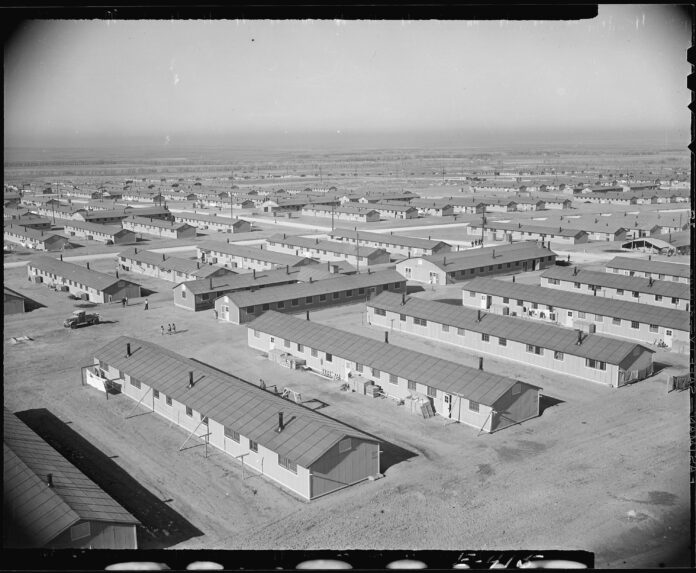Amache National Historic Site in Southeastern Colorado is now the newest national park. Amache, also known as the Granada Relocation Center, was one of 10 incarceration camps that detained Japanese Americans under Executive Order 9066 during World War II, forcibly removing them from their West Coast homes. Amache joins six other national parks already established to preserve this part of American history.
CBS News reports that the town of Granada, Colo., acquired and donated the land needed to establish the site as a national park. In 2022, President Joe Biden designated Amache as part of the National Park System. On Thursday, ahead of the National Day of Remembrance of Japanese Incarceration on Feb. 19, Secretary of the Interior Deb Haaland formally established the Amache National Historic Site.
According to a press release issued by the National Park Service, more than 10,000 people were incarcerated at Amache during World War II, which housed 7,310 Japanese Americans at its peak.
“As a nation, we must face the wrongs of our past in order to build a more just and equitable future. The Interior Department has the tremendous honor of stewarding America’s public lands and natural and cultural resources to tell a complete and honest story of our nation’s history,” Haaland said in the release. “Today’s establishment of the Amache National Historic Site will help preserve and honor this important and painful chapter in our nation’s story for future generations.”
Today, what remains of Amache was preserved through the years by survivors, their descendants, the town of Granada, and a group from the local Granada High School led by social studies teacher John Hopper, according to the Denver Post.
In 1993, Hopper launched a “living history” program for students to help care for the grounds of Amache, particularly the camp’s cemetery, in preparation for a an annual pilgrimage undertaken by Amache descendants, who return to the site each May. The program grew into the Amache Preservation Society, through which Hopper and his students restored a guard tower, water tower, mess hall and barracks to the site. Concrete foundations, along with the original roads, remain intact.
The Denver Post reports that the original intent for designating Amache as a Historic Site was to increase eligible funding for preservation efforts. It’s designation as a national park will also bring greater attention to a shameful and dark period of American history.
“Amache’s addition to the National Park System is a reminder that a complete account of the nation’s history must include our dark chapters of injustice,” National Park Service Director Chuck Sams said, according to the release. “To heal and grow as a nation, we need to reflect on past mistakes, make amends, and strive to form a more perfect union.”
Support our June Membership Drive and receive member-only benefits. Help us reach our goal of $10,000 in new donations and monthly and annual donation pledges by the end of the Month.
We are published by the non-profit Asian American Media Inc and supported by our readers along with the Robert Wood Johnson Foundation, AARP, Report for America/GroundTruth Project & Koo and Patricia Yuen of the Yuen Foundation.
You can make your tax-deductible donations here via credit card, debit card, Apple Pay, Google Pay, PayPal and Venmo. Stock donations and donations via DAFs are also welcomed. Contact us at info @ asamnews dot com for more info.





Hey, you guys, you seem to be still using the phrase “internment camp”. For several years we have been trying to get that term out of the literature and elsewhere, and using “incarceration camp” or other words. The 10 major camps were not “internment camps” legally, since that term should be used for the DOJ camps that were for “aliens”, or our grandparents and parents who were not citizens. It may seem like a quibble, but terminology has always been an issue in talking about the camps, so let’s try harder to be correct in our use of words.
Thanks.
Chizu Omori
Thank you for bringing that to our attention. That should not have happened. Our policy is to not use the term “interment” when talking about the Japanese American experience during WWII.
Thanks for that Chizu!
For reference, the AP Stylebook used by major newsrooms, clarifies that using “internment” to describe the WWII JA incarceration is INACCURATE. For further guidance on terminology, see the following:
NPS guide to terminology of the Japanese American incarceration —
https://www.nps.gov/articles/000/terminology-and-the-mass-incarceration-of-japanese-americans-during-world-war-ii.htm
Legal discussion of “internment” —
https://digitalcommons.law.seattleu.edu/cgi/viewcontent.cgi?article=1834&context=sjsj